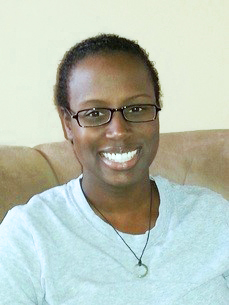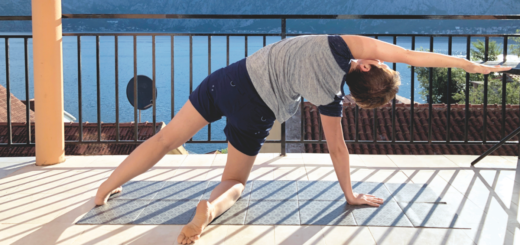Why therapeutic yoga belongs in the counseling sessions
3A female client comes in regarding depression and anxiety concerns. She has been to three different therapists, seeking help. Looking distraught and overwhelmed, she states that she came to me because I offer something different than other therapists. She says that she needs “to slow her mind down” and “get out of the funk” she has been in. She wants to live a life that is whole and full of purpose again. After talking with one another, we begin our work.
Breath awareness, moving the body with the breath, pausing, moving, again. A short sequence of repeating this flow continues until she is resting in Savasana. We complete the session with a short breath practice followed by meditation.
Afterwards, the client looks peaceful. The widening of the eyes has softened. The breath that was rapid at the beginning has lengthened, slowed down. She mentions that this is the first time she had been present in her body since bad things happened to her early in life. Later I found out that she was a survivor of trauma.
Our work continues for the next few months. Talking, doing experiential work in and outside of our sessions, and being present/mindful to what life brings us. The client is doing very well; she continues to work on short yoga therapy practices given to her and has other mindfulness tools in her toolbox to use, if needed.
This example above reminds me why I find this work so rewarding. Many people have tried traditional talk therapy and medication; it works for some. Others feel like they need more support. They are not looking for a “quick fix” and feel like they are not being heard. They are looking to have more understanding of their behaviors and thoughts.
The eight limbs of yoga, when used as a technique, can assist us with that.
The yamas and niyamas can serve as guidelines for ethical behavior for ourselves and how we interact with others and our environment. Asana practice, from the therapeutic standpoint, can help to shift energy, and how the person is thinking or feeling. Pranayama practices help calm the nervous system, increasing the parasympathetic response and lowering the stress response that is always present in our bodies. The final four limbs of yoga are dedicated to meditation and teach us how to become more clear, focused, aware, and realize that we are all connected, and part of something greater, the Source.
I became intimate with this work in my own life. A survivor of physical and sexual trauma, drug addiction, depression/anxiety concerns, living with disability (multiple sclerosis), and immersing deeper in spirituality than ever before. I was someone who was running away from my body and heart. The proper term for it is dissociation. Because of so much pain, I was doing anything to get away from it. This continued until a therapist suggested that I incorporated a “mind-body practice” in my life.
I stumbled upon yoga. I did not understand most of the yogic terminology at the time. I remember the teacher telling the class to “follow the inhalation and exhalation of your breath.” Using breath as an anchor I was about to “come back home” to my mind, body, and heart. I was able to be present with of all of these entities. And yes, it is still a process for me, too.
When I started this work, I thought to myself, “Who is going to utilize these services?” It was so different and “out there.” It was nowhere near as prevalent as it is now. I had to remind myself of the following:
1. We are multidimensional beings, so this type of work is needed.
People are looking for more integrative approaches to care, including mental/emotional health. Individuals want to be more in control of their care. Combining counseling and yoga therapy helps to create this bridge. Especially as we are in a public health crisis, these types of services are needed now more than ever.
2. Holding the space for your client is essential.
In this approach working with your clients can be rocky as they begin to learn new things about themselves. Rather than coming from the typical model of trying to fix someone, can you hold the space for them? Is it hard? Yes, it is; yet it is one of the most critical and beneficial things. Through the different techniques of yoga and psychology the clients will grow, learn and thrive to their fullest potential as human beings.
3. Trust in the process for yourself as a therapist.
There will be times when you may question your own abilities. Rather than ruminate and become negative, trust in the process for yourself as a therapist. Practice your own yoga and meditation daily. Read texts (psychology, yoga, etc.) that will inform and assist you on your own journey as a therapist. By doing this, you gain more knowledge and depth for your work. This will translate and inform your work with others.
Society is beginning to see the benefits of therapeutic yoga for many different mental health/emotional concerns: trauma/addiction recovery, depression, anxiety, grief, and many others. Counseling and yoga therapy complement one another. They are both needed in the communities we serve, now more than ever.
I will leave you with this quote:
“Between stimulus and response, there is a space.
In that space is our power to choose our response.
In our response lies our growth and our freedom.” – Viktor Frankl
Sample yoga practice – Create Better Boundaries (pdf)
![]()

Jennifer (Jenn) Del Castillo is a licensed professional counselor and yoga therapist. She provides a variety of integrative services including counseling and yoga therapy to the metro Atlanta area community and online.
You can Jenn on the web: yourmindfulpath.com
Facebook: Your Mindful Path
Twitter/Instagram: @jenndelcastillo
[jetpack_subscription_form title=”Read more stories from yoga teachers who found their unique voice “]






















Lovely article. Good quote. Can’t go wrong with V. Frankl. As a LMFT and yoga teacher since 1987, I appreciate the blend.
Light and Love.
Thank you Sandraz for your kind words. As a fellow colleague in the field, you understand the potential that can happen with clients when these 2 disciplines come together.
My best to you on your journey.
Jenn,
Thank you for this exceptional article. I use that quote often, it’s one of my favorites. It never ceases to amaze me that when we bring yoga and mindfulness into the counseling session amazing things happen. Your work and writings are appreciated.